The Transformation of Australian Financial Institutions Report FIN203
VerifiedAdded on 2022/11/13
|15
|3563
|171
Report
AI Summary
This report provides an executive summary and in-depth analysis of the Australian financial sector, particularly focusing on the impact of deregulation on non-bank financial institutions such as credit unions and building societies. The report explores the historical context of government regulations, the rationale behind deregulation in the 1980s, and the subsequent changes within the financial landscape. It examines the factors driving the transformation of credit unions and building societies into banks, including mergers, rebranding, and the pursuit of competitiveness. The analysis includes a review of relevant literature and offers recommendations based on the observed trends and implications of these shifts. The report highlights the increasing competition, the evolving roles of financial institutions, and the overall impact of deregulation on the Australian economy and its financial services.
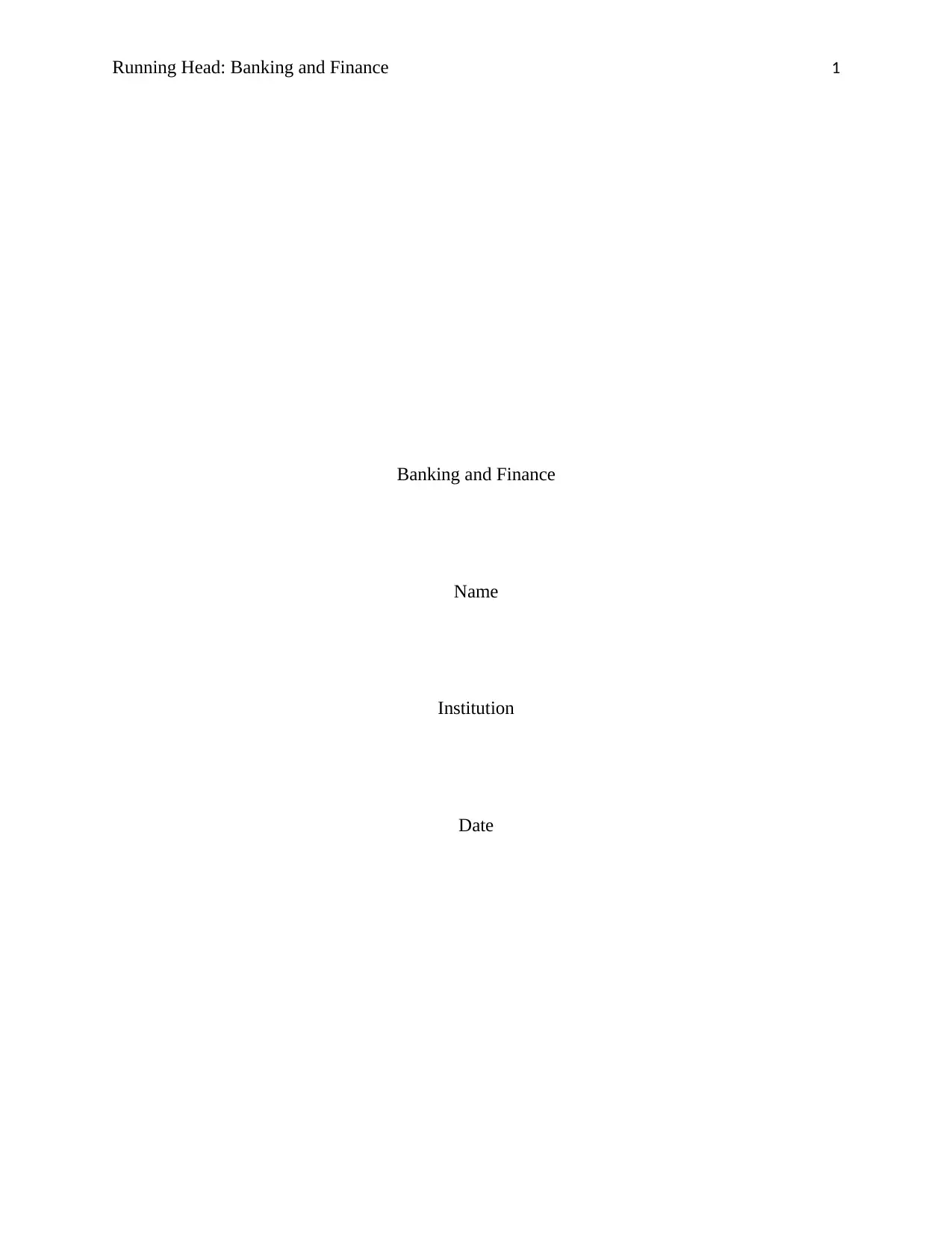
Running Head: Banking and Finance 1
Banking and Finance
Name
Institution
Date
Banking and Finance
Name
Institution
Date
Paraphrase This Document
Need a fresh take? Get an instant paraphrase of this document with our AI Paraphraser
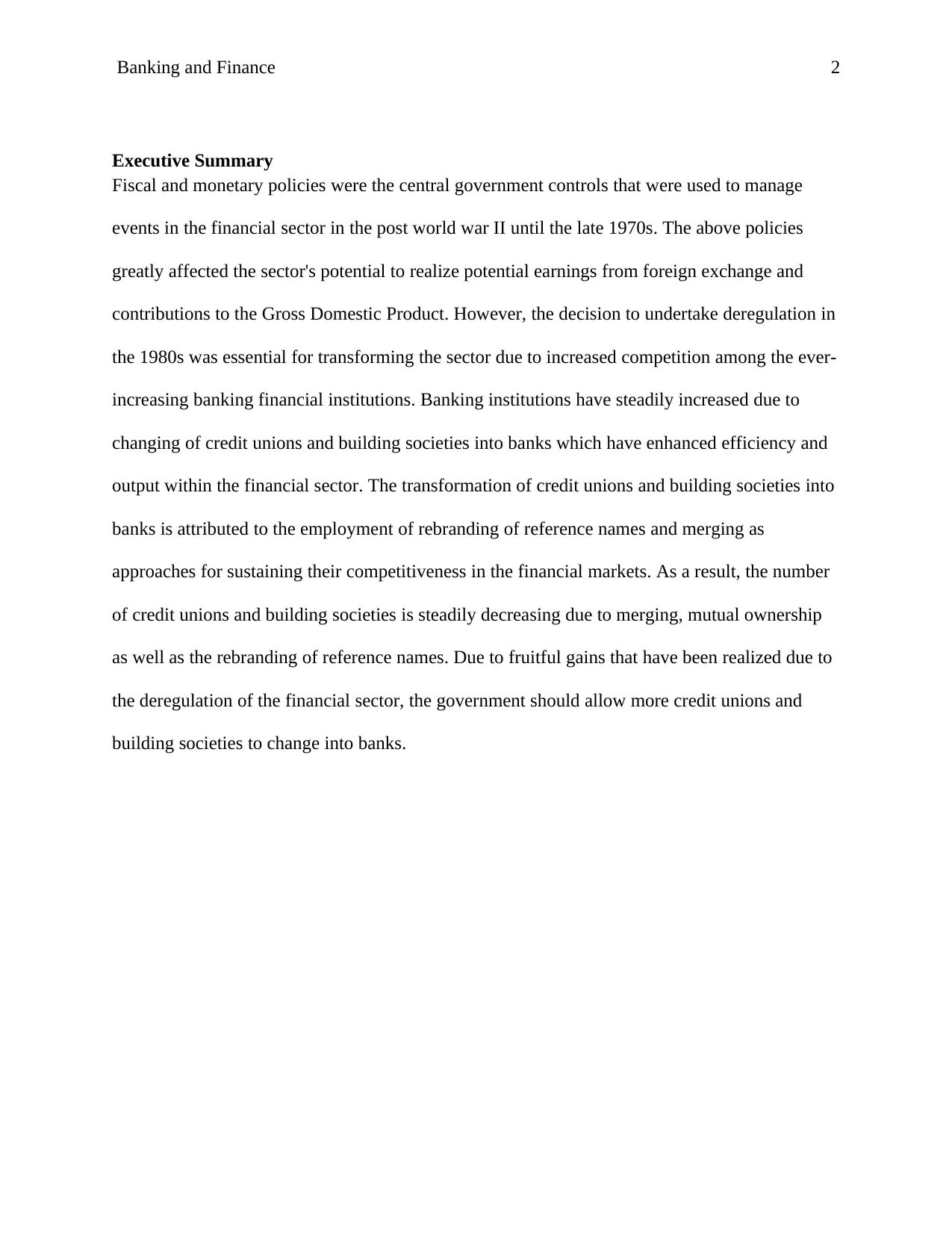
Banking and Finance 2
Executive Summary
Fiscal and monetary policies were the central government controls that were used to manage
events in the financial sector in the post world war II until the late 1970s. The above policies
greatly affected the sector's potential to realize potential earnings from foreign exchange and
contributions to the Gross Domestic Product. However, the decision to undertake deregulation in
the 1980s was essential for transforming the sector due to increased competition among the ever-
increasing banking financial institutions. Banking institutions have steadily increased due to
changing of credit unions and building societies into banks which have enhanced efficiency and
output within the financial sector. The transformation of credit unions and building societies into
banks is attributed to the employment of rebranding of reference names and merging as
approaches for sustaining their competitiveness in the financial markets. As a result, the number
of credit unions and building societies is steadily decreasing due to merging, mutual ownership
as well as the rebranding of reference names. Due to fruitful gains that have been realized due to
the deregulation of the financial sector, the government should allow more credit unions and
building societies to change into banks.
Executive Summary
Fiscal and monetary policies were the central government controls that were used to manage
events in the financial sector in the post world war II until the late 1970s. The above policies
greatly affected the sector's potential to realize potential earnings from foreign exchange and
contributions to the Gross Domestic Product. However, the decision to undertake deregulation in
the 1980s was essential for transforming the sector due to increased competition among the ever-
increasing banking financial institutions. Banking institutions have steadily increased due to
changing of credit unions and building societies into banks which have enhanced efficiency and
output within the financial sector. The transformation of credit unions and building societies into
banks is attributed to the employment of rebranding of reference names and merging as
approaches for sustaining their competitiveness in the financial markets. As a result, the number
of credit unions and building societies is steadily decreasing due to merging, mutual ownership
as well as the rebranding of reference names. Due to fruitful gains that have been realized due to
the deregulation of the financial sector, the government should allow more credit unions and
building societies to change into banks.
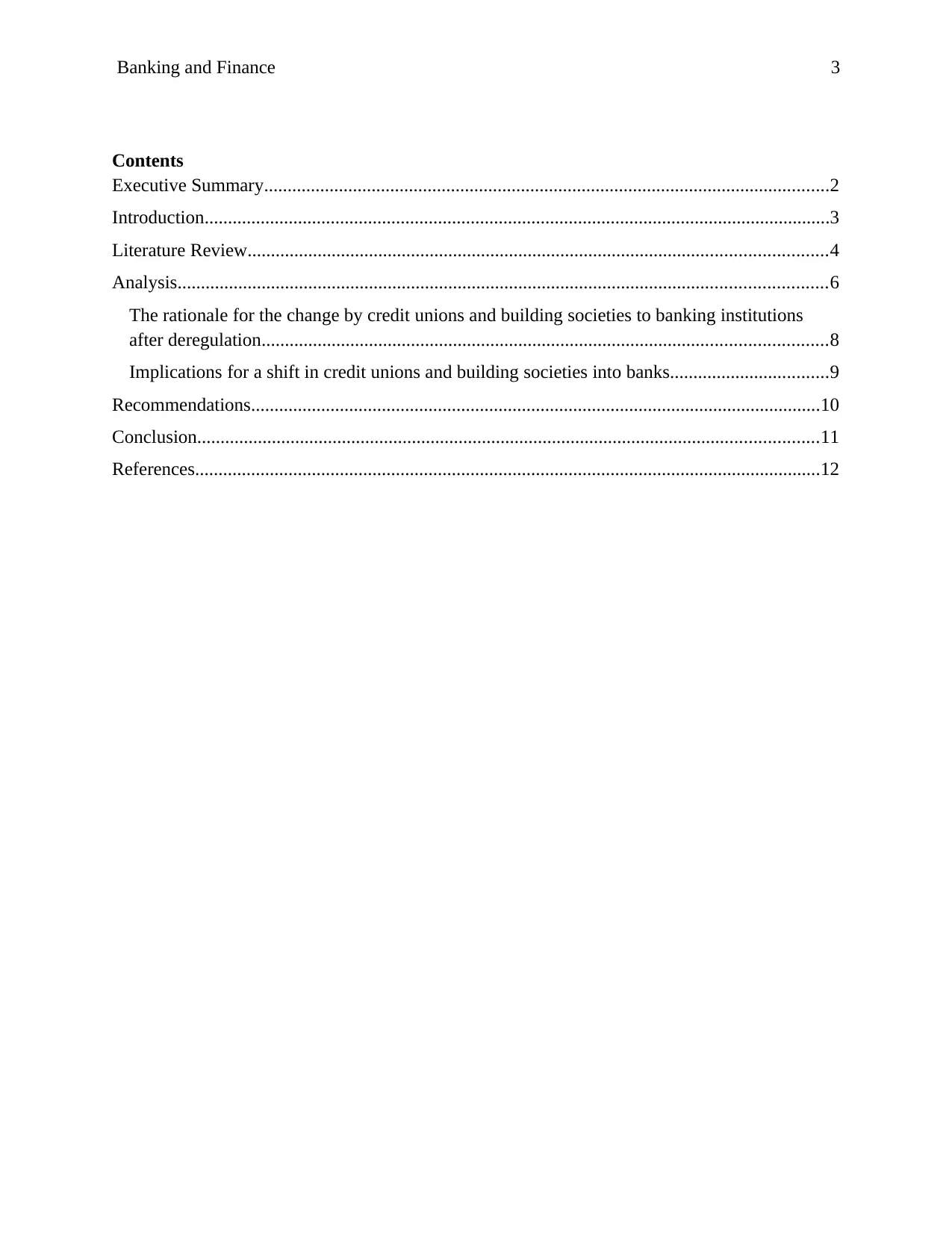
Banking and Finance 3
Contents
Executive Summary.........................................................................................................................2
Introduction......................................................................................................................................3
Literature Review............................................................................................................................4
Analysis...........................................................................................................................................6
The rationale for the change by credit unions and building societies to banking institutions
after deregulation.........................................................................................................................8
Implications for a shift in credit unions and building societies into banks..................................9
Recommendations..........................................................................................................................10
Conclusion.....................................................................................................................................11
References......................................................................................................................................12
Contents
Executive Summary.........................................................................................................................2
Introduction......................................................................................................................................3
Literature Review............................................................................................................................4
Analysis...........................................................................................................................................6
The rationale for the change by credit unions and building societies to banking institutions
after deregulation.........................................................................................................................8
Implications for a shift in credit unions and building societies into banks..................................9
Recommendations..........................................................................................................................10
Conclusion.....................................................................................................................................11
References......................................................................................................................................12
⊘ This is a preview!⊘
Do you want full access?
Subscribe today to unlock all pages.

Trusted by 1+ million students worldwide
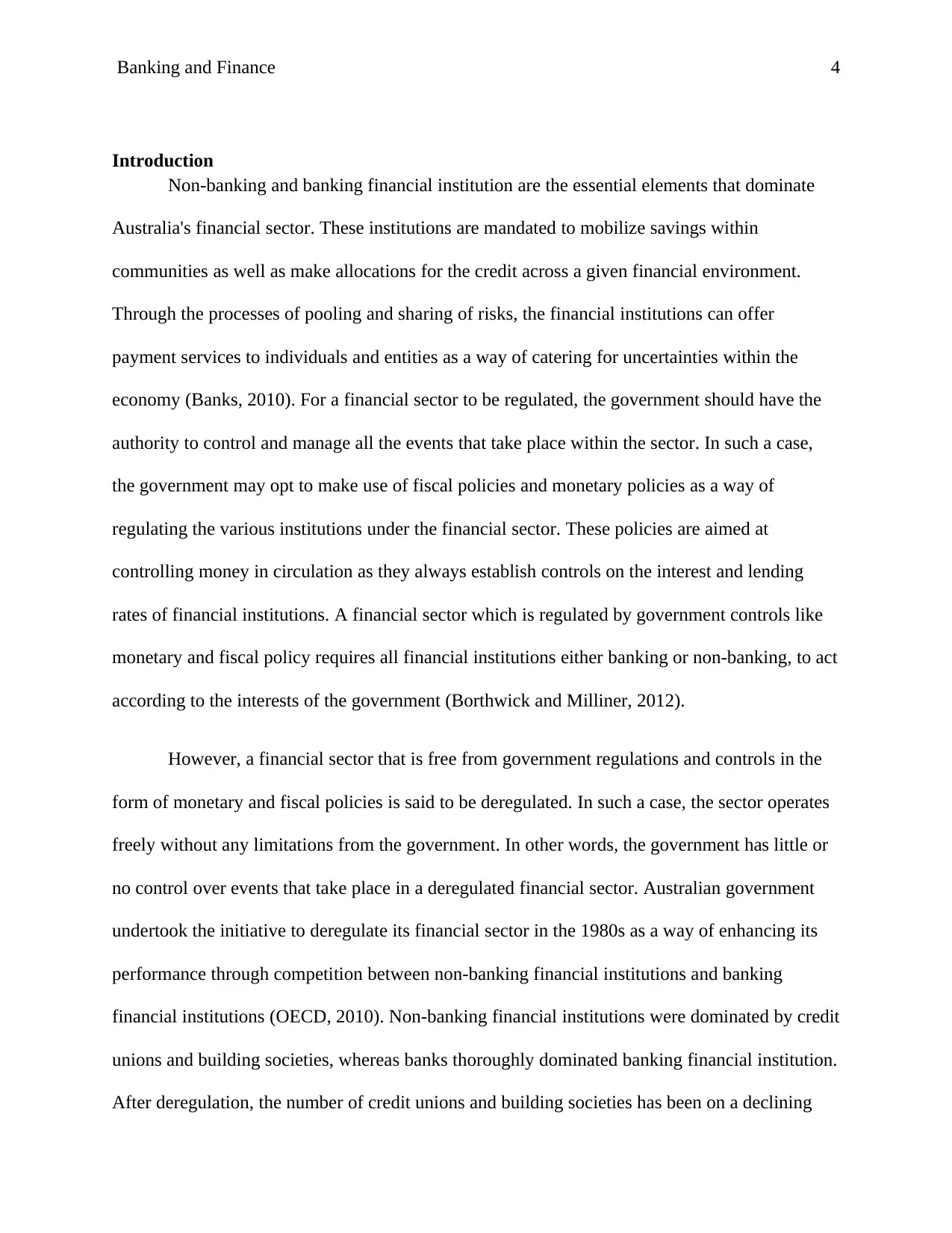
Banking and Finance 4
Introduction
Non-banking and banking financial institution are the essential elements that dominate
Australia's financial sector. These institutions are mandated to mobilize savings within
communities as well as make allocations for the credit across a given financial environment.
Through the processes of pooling and sharing of risks, the financial institutions can offer
payment services to individuals and entities as a way of catering for uncertainties within the
economy (Banks, 2010). For a financial sector to be regulated, the government should have the
authority to control and manage all the events that take place within the sector. In such a case,
the government may opt to make use of fiscal policies and monetary policies as a way of
regulating the various institutions under the financial sector. These policies are aimed at
controlling money in circulation as they always establish controls on the interest and lending
rates of financial institutions. A financial sector which is regulated by government controls like
monetary and fiscal policy requires all financial institutions either banking or non-banking, to act
according to the interests of the government (Borthwick and Milliner, 2012).
However, a financial sector that is free from government regulations and controls in the
form of monetary and fiscal policies is said to be deregulated. In such a case, the sector operates
freely without any limitations from the government. In other words, the government has little or
no control over events that take place in a deregulated financial sector. Australian government
undertook the initiative to deregulate its financial sector in the 1980s as a way of enhancing its
performance through competition between non-banking financial institutions and banking
financial institutions (OECD, 2010). Non-banking financial institutions were dominated by credit
unions and building societies, whereas banks thoroughly dominated banking financial institution.
After deregulation, the number of credit unions and building societies has been on a declining
Introduction
Non-banking and banking financial institution are the essential elements that dominate
Australia's financial sector. These institutions are mandated to mobilize savings within
communities as well as make allocations for the credit across a given financial environment.
Through the processes of pooling and sharing of risks, the financial institutions can offer
payment services to individuals and entities as a way of catering for uncertainties within the
economy (Banks, 2010). For a financial sector to be regulated, the government should have the
authority to control and manage all the events that take place within the sector. In such a case,
the government may opt to make use of fiscal policies and monetary policies as a way of
regulating the various institutions under the financial sector. These policies are aimed at
controlling money in circulation as they always establish controls on the interest and lending
rates of financial institutions. A financial sector which is regulated by government controls like
monetary and fiscal policy requires all financial institutions either banking or non-banking, to act
according to the interests of the government (Borthwick and Milliner, 2012).
However, a financial sector that is free from government regulations and controls in the
form of monetary and fiscal policies is said to be deregulated. In such a case, the sector operates
freely without any limitations from the government. In other words, the government has little or
no control over events that take place in a deregulated financial sector. Australian government
undertook the initiative to deregulate its financial sector in the 1980s as a way of enhancing its
performance through competition between non-banking financial institutions and banking
financial institutions (OECD, 2010). Non-banking financial institutions were dominated by credit
unions and building societies, whereas banks thoroughly dominated banking financial institution.
After deregulation, the number of credit unions and building societies has been on a declining
Paraphrase This Document
Need a fresh take? Get an instant paraphrase of this document with our AI Paraphraser
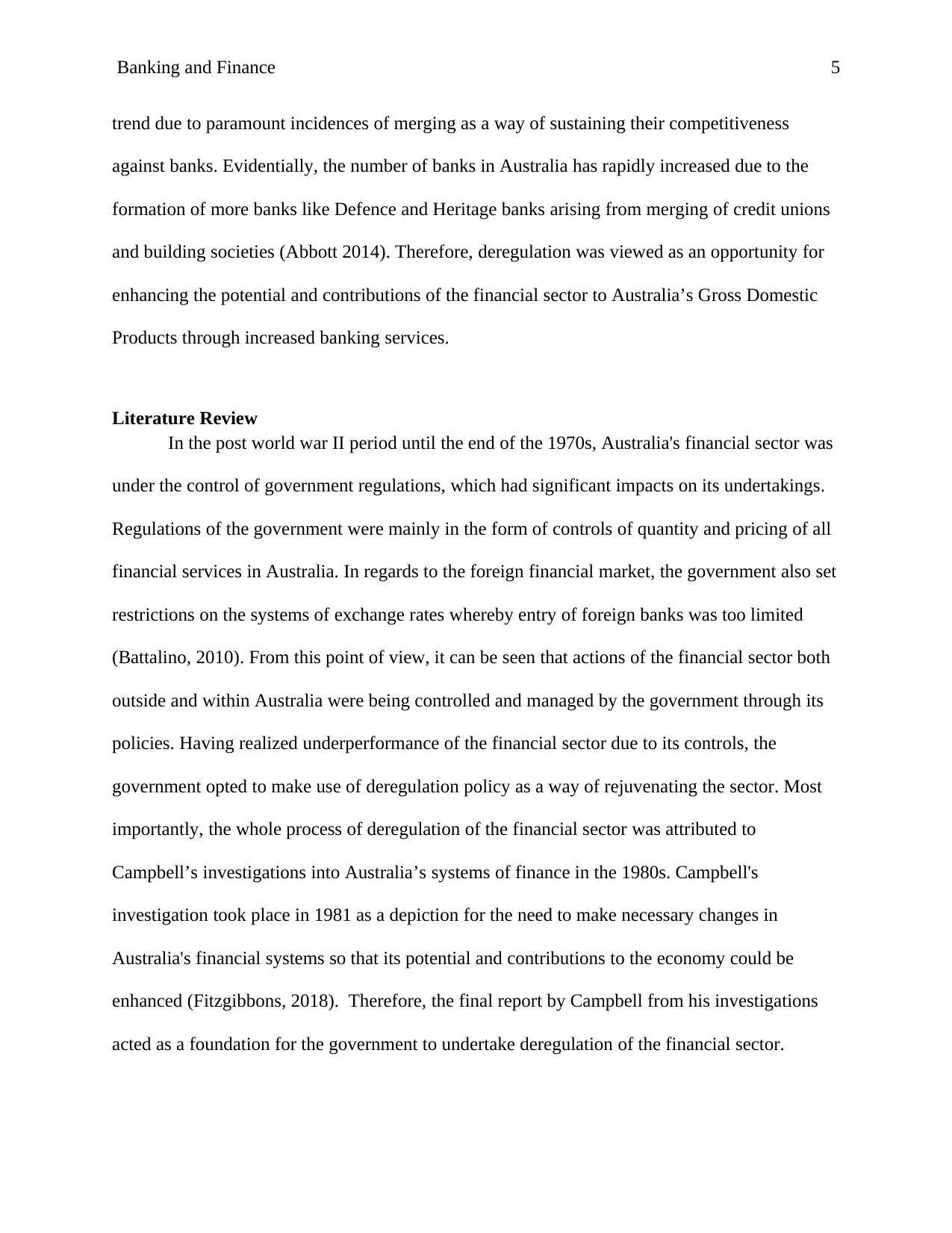
Banking and Finance 5
trend due to paramount incidences of merging as a way of sustaining their competitiveness
against banks. Evidentially, the number of banks in Australia has rapidly increased due to the
formation of more banks like Defence and Heritage banks arising from merging of credit unions
and building societies (Abbott 2014). Therefore, deregulation was viewed as an opportunity for
enhancing the potential and contributions of the financial sector to Australia’s Gross Domestic
Products through increased banking services.
Literature Review
In the post world war II period until the end of the 1970s, Australia's financial sector was
under the control of government regulations, which had significant impacts on its undertakings.
Regulations of the government were mainly in the form of controls of quantity and pricing of all
financial services in Australia. In regards to the foreign financial market, the government also set
restrictions on the systems of exchange rates whereby entry of foreign banks was too limited
(Battalino, 2010). From this point of view, it can be seen that actions of the financial sector both
outside and within Australia were being controlled and managed by the government through its
policies. Having realized underperformance of the financial sector due to its controls, the
government opted to make use of deregulation policy as a way of rejuvenating the sector. Most
importantly, the whole process of deregulation of the financial sector was attributed to
Campbell’s investigations into Australia’s systems of finance in the 1980s. Campbell's
investigation took place in 1981 as a depiction for the need to make necessary changes in
Australia's financial systems so that its potential and contributions to the economy could be
enhanced (Fitzgibbons, 2018). Therefore, the final report by Campbell from his investigations
acted as a foundation for the government to undertake deregulation of the financial sector.
trend due to paramount incidences of merging as a way of sustaining their competitiveness
against banks. Evidentially, the number of banks in Australia has rapidly increased due to the
formation of more banks like Defence and Heritage banks arising from merging of credit unions
and building societies (Abbott 2014). Therefore, deregulation was viewed as an opportunity for
enhancing the potential and contributions of the financial sector to Australia’s Gross Domestic
Products through increased banking services.
Literature Review
In the post world war II period until the end of the 1970s, Australia's financial sector was
under the control of government regulations, which had significant impacts on its undertakings.
Regulations of the government were mainly in the form of controls of quantity and pricing of all
financial services in Australia. In regards to the foreign financial market, the government also set
restrictions on the systems of exchange rates whereby entry of foreign banks was too limited
(Battalino, 2010). From this point of view, it can be seen that actions of the financial sector both
outside and within Australia were being controlled and managed by the government through its
policies. Having realized underperformance of the financial sector due to its controls, the
government opted to make use of deregulation policy as a way of rejuvenating the sector. Most
importantly, the whole process of deregulation of the financial sector was attributed to
Campbell’s investigations into Australia’s systems of finance in the 1980s. Campbell's
investigation took place in 1981 as a depiction for the need to make necessary changes in
Australia's financial systems so that its potential and contributions to the economy could be
enhanced (Fitzgibbons, 2018). Therefore, the final report by Campbell from his investigations
acted as a foundation for the government to undertake deregulation of the financial sector.
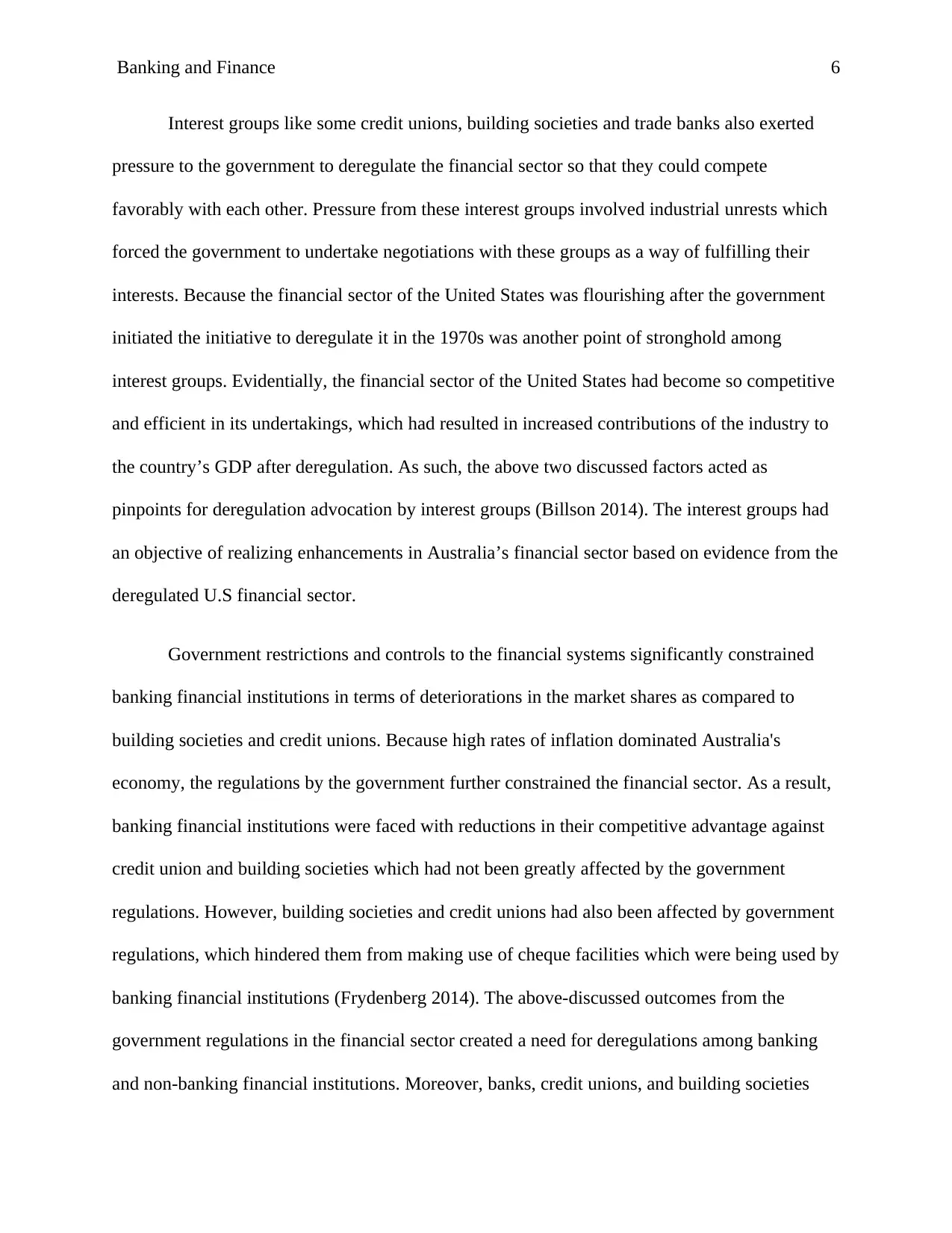
Banking and Finance 6
Interest groups like some credit unions, building societies and trade banks also exerted
pressure to the government to deregulate the financial sector so that they could compete
favorably with each other. Pressure from these interest groups involved industrial unrests which
forced the government to undertake negotiations with these groups as a way of fulfilling their
interests. Because the financial sector of the United States was flourishing after the government
initiated the initiative to deregulate it in the 1970s was another point of stronghold among
interest groups. Evidentially, the financial sector of the United States had become so competitive
and efficient in its undertakings, which had resulted in increased contributions of the industry to
the country’s GDP after deregulation. As such, the above two discussed factors acted as
pinpoints for deregulation advocation by interest groups (Billson 2014). The interest groups had
an objective of realizing enhancements in Australia’s financial sector based on evidence from the
deregulated U.S financial sector.
Government restrictions and controls to the financial systems significantly constrained
banking financial institutions in terms of deteriorations in the market shares as compared to
building societies and credit unions. Because high rates of inflation dominated Australia's
economy, the regulations by the government further constrained the financial sector. As a result,
banking financial institutions were faced with reductions in their competitive advantage against
credit union and building societies which had not been greatly affected by the government
regulations. However, building societies and credit unions had also been affected by government
regulations, which hindered them from making use of cheque facilities which were being used by
banking financial institutions (Frydenberg 2014). The above-discussed outcomes from the
government regulations in the financial sector created a need for deregulations among banking
and non-banking financial institutions. Moreover, banks, credit unions, and building societies
Interest groups like some credit unions, building societies and trade banks also exerted
pressure to the government to deregulate the financial sector so that they could compete
favorably with each other. Pressure from these interest groups involved industrial unrests which
forced the government to undertake negotiations with these groups as a way of fulfilling their
interests. Because the financial sector of the United States was flourishing after the government
initiated the initiative to deregulate it in the 1970s was another point of stronghold among
interest groups. Evidentially, the financial sector of the United States had become so competitive
and efficient in its undertakings, which had resulted in increased contributions of the industry to
the country’s GDP after deregulation. As such, the above two discussed factors acted as
pinpoints for deregulation advocation by interest groups (Billson 2014). The interest groups had
an objective of realizing enhancements in Australia’s financial sector based on evidence from the
deregulated U.S financial sector.
Government restrictions and controls to the financial systems significantly constrained
banking financial institutions in terms of deteriorations in the market shares as compared to
building societies and credit unions. Because high rates of inflation dominated Australia's
economy, the regulations by the government further constrained the financial sector. As a result,
banking financial institutions were faced with reductions in their competitive advantage against
credit union and building societies which had not been greatly affected by the government
regulations. However, building societies and credit unions had also been affected by government
regulations, which hindered them from making use of cheque facilities which were being used by
banking financial institutions (Frydenberg 2014). The above-discussed outcomes from the
government regulations in the financial sector created a need for deregulations among banking
and non-banking financial institutions. Moreover, banks, credit unions, and building societies
⊘ This is a preview!⊘
Do you want full access?
Subscribe today to unlock all pages.

Trusted by 1+ million students worldwide
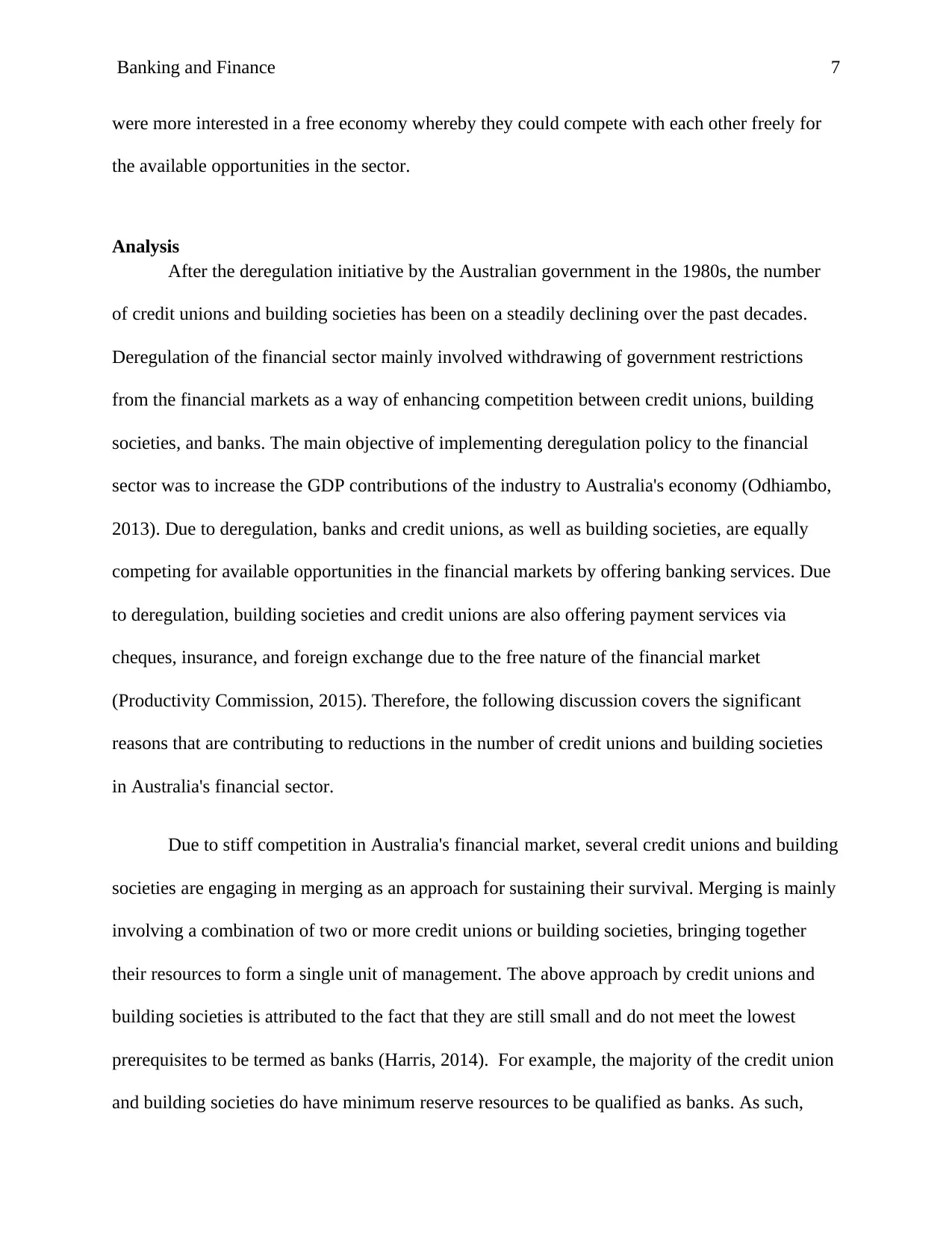
Banking and Finance 7
were more interested in a free economy whereby they could compete with each other freely for
the available opportunities in the sector.
Analysis
After the deregulation initiative by the Australian government in the 1980s, the number
of credit unions and building societies has been on a steadily declining over the past decades.
Deregulation of the financial sector mainly involved withdrawing of government restrictions
from the financial markets as a way of enhancing competition between credit unions, building
societies, and banks. The main objective of implementing deregulation policy to the financial
sector was to increase the GDP contributions of the industry to Australia's economy (Odhiambo,
2013). Due to deregulation, banks and credit unions, as well as building societies, are equally
competing for available opportunities in the financial markets by offering banking services. Due
to deregulation, building societies and credit unions are also offering payment services via
cheques, insurance, and foreign exchange due to the free nature of the financial market
(Productivity Commission, 2015). Therefore, the following discussion covers the significant
reasons that are contributing to reductions in the number of credit unions and building societies
in Australia's financial sector.
Due to stiff competition in Australia's financial market, several credit unions and building
societies are engaging in merging as an approach for sustaining their survival. Merging is mainly
involving a combination of two or more credit unions or building societies, bringing together
their resources to form a single unit of management. The above approach by credit unions and
building societies is attributed to the fact that they are still small and do not meet the lowest
prerequisites to be termed as banks (Harris, 2014). For example, the majority of the credit union
and building societies do have minimum reserve resources to be qualified as banks. As such,
were more interested in a free economy whereby they could compete with each other freely for
the available opportunities in the sector.
Analysis
After the deregulation initiative by the Australian government in the 1980s, the number
of credit unions and building societies has been on a steadily declining over the past decades.
Deregulation of the financial sector mainly involved withdrawing of government restrictions
from the financial markets as a way of enhancing competition between credit unions, building
societies, and banks. The main objective of implementing deregulation policy to the financial
sector was to increase the GDP contributions of the industry to Australia's economy (Odhiambo,
2013). Due to deregulation, banks and credit unions, as well as building societies, are equally
competing for available opportunities in the financial markets by offering banking services. Due
to deregulation, building societies and credit unions are also offering payment services via
cheques, insurance, and foreign exchange due to the free nature of the financial market
(Productivity Commission, 2015). Therefore, the following discussion covers the significant
reasons that are contributing to reductions in the number of credit unions and building societies
in Australia's financial sector.
Due to stiff competition in Australia's financial market, several credit unions and building
societies are engaging in merging as an approach for sustaining their survival. Merging is mainly
involving a combination of two or more credit unions or building societies, bringing together
their resources to form a single unit of management. The above approach by credit unions and
building societies is attributed to the fact that they are still small and do not meet the lowest
prerequisites to be termed as banks (Harris, 2014). For example, the majority of the credit union
and building societies do have minimum reserve resources to be qualified as banks. As such,
Paraphrase This Document
Need a fresh take? Get an instant paraphrase of this document with our AI Paraphraser
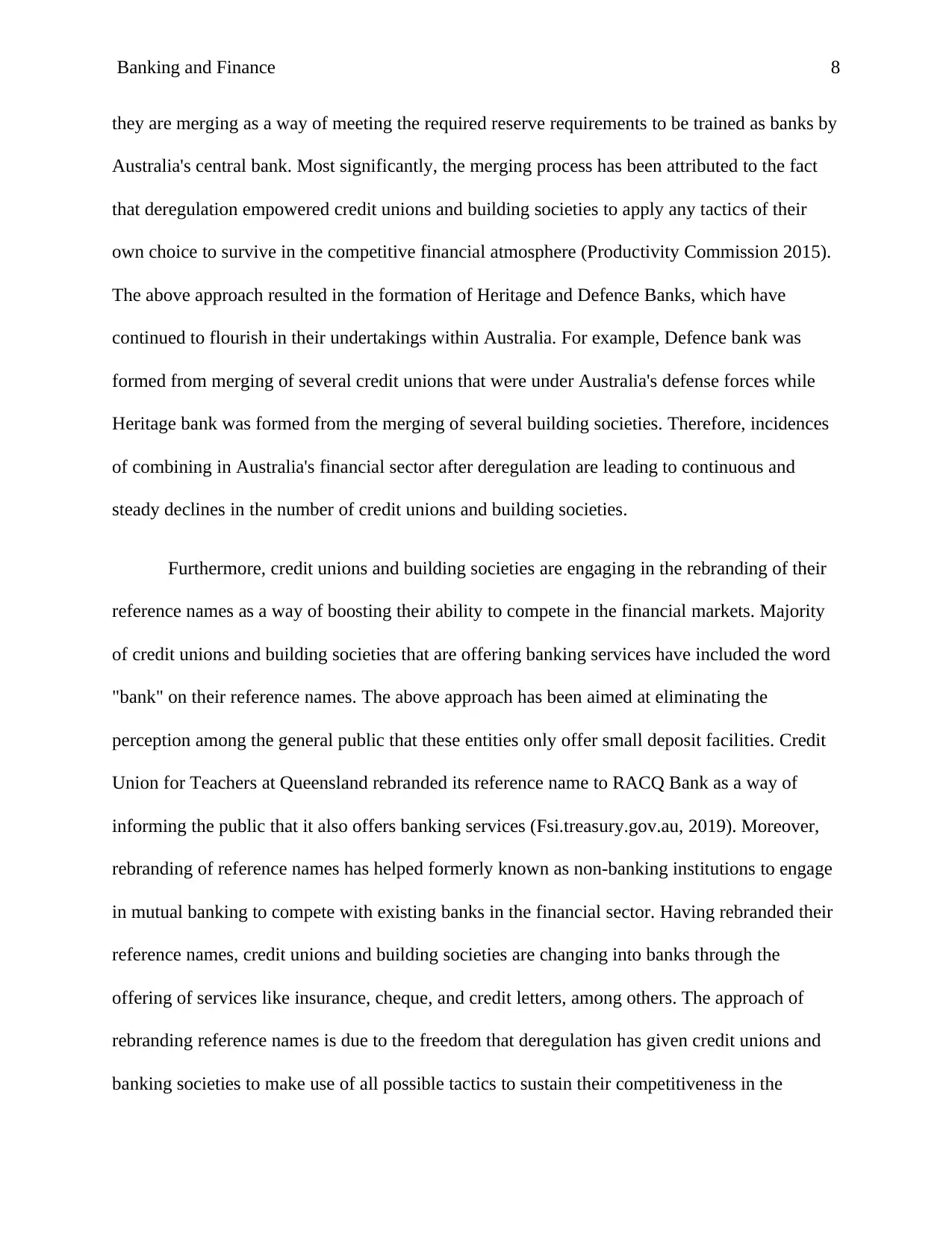
Banking and Finance 8
they are merging as a way of meeting the required reserve requirements to be trained as banks by
Australia's central bank. Most significantly, the merging process has been attributed to the fact
that deregulation empowered credit unions and building societies to apply any tactics of their
own choice to survive in the competitive financial atmosphere (Productivity Commission 2015).
The above approach resulted in the formation of Heritage and Defence Banks, which have
continued to flourish in their undertakings within Australia. For example, Defence bank was
formed from merging of several credit unions that were under Australia's defense forces while
Heritage bank was formed from the merging of several building societies. Therefore, incidences
of combining in Australia's financial sector after deregulation are leading to continuous and
steady declines in the number of credit unions and building societies.
Furthermore, credit unions and building societies are engaging in the rebranding of their
reference names as a way of boosting their ability to compete in the financial markets. Majority
of credit unions and building societies that are offering banking services have included the word
"bank" on their reference names. The above approach has been aimed at eliminating the
perception among the general public that these entities only offer small deposit facilities. Credit
Union for Teachers at Queensland rebranded its reference name to RACQ Bank as a way of
informing the public that it also offers banking services (Fsi.treasury.gov.au, 2019). Moreover,
rebranding of reference names has helped formerly known as non-banking institutions to engage
in mutual banking to compete with existing banks in the financial sector. Having rebranded their
reference names, credit unions and building societies are changing into banks through the
offering of services like insurance, cheque, and credit letters, among others. The approach of
rebranding reference names is due to the freedom that deregulation has given credit unions and
banking societies to make use of all possible tactics to sustain their competitiveness in the
they are merging as a way of meeting the required reserve requirements to be trained as banks by
Australia's central bank. Most significantly, the merging process has been attributed to the fact
that deregulation empowered credit unions and building societies to apply any tactics of their
own choice to survive in the competitive financial atmosphere (Productivity Commission 2015).
The above approach resulted in the formation of Heritage and Defence Banks, which have
continued to flourish in their undertakings within Australia. For example, Defence bank was
formed from merging of several credit unions that were under Australia's defense forces while
Heritage bank was formed from the merging of several building societies. Therefore, incidences
of combining in Australia's financial sector after deregulation are leading to continuous and
steady declines in the number of credit unions and building societies.
Furthermore, credit unions and building societies are engaging in the rebranding of their
reference names as a way of boosting their ability to compete in the financial markets. Majority
of credit unions and building societies that are offering banking services have included the word
"bank" on their reference names. The above approach has been aimed at eliminating the
perception among the general public that these entities only offer small deposit facilities. Credit
Union for Teachers at Queensland rebranded its reference name to RACQ Bank as a way of
informing the public that it also offers banking services (Fsi.treasury.gov.au, 2019). Moreover,
rebranding of reference names has helped formerly known as non-banking institutions to engage
in mutual banking to compete with existing banks in the financial sector. Having rebranded their
reference names, credit unions and building societies are changing into banks through the
offering of services like insurance, cheque, and credit letters, among others. The approach of
rebranding reference names is due to the freedom that deregulation has given credit unions and
banking societies to make use of all possible tactics to sustain their competitiveness in the
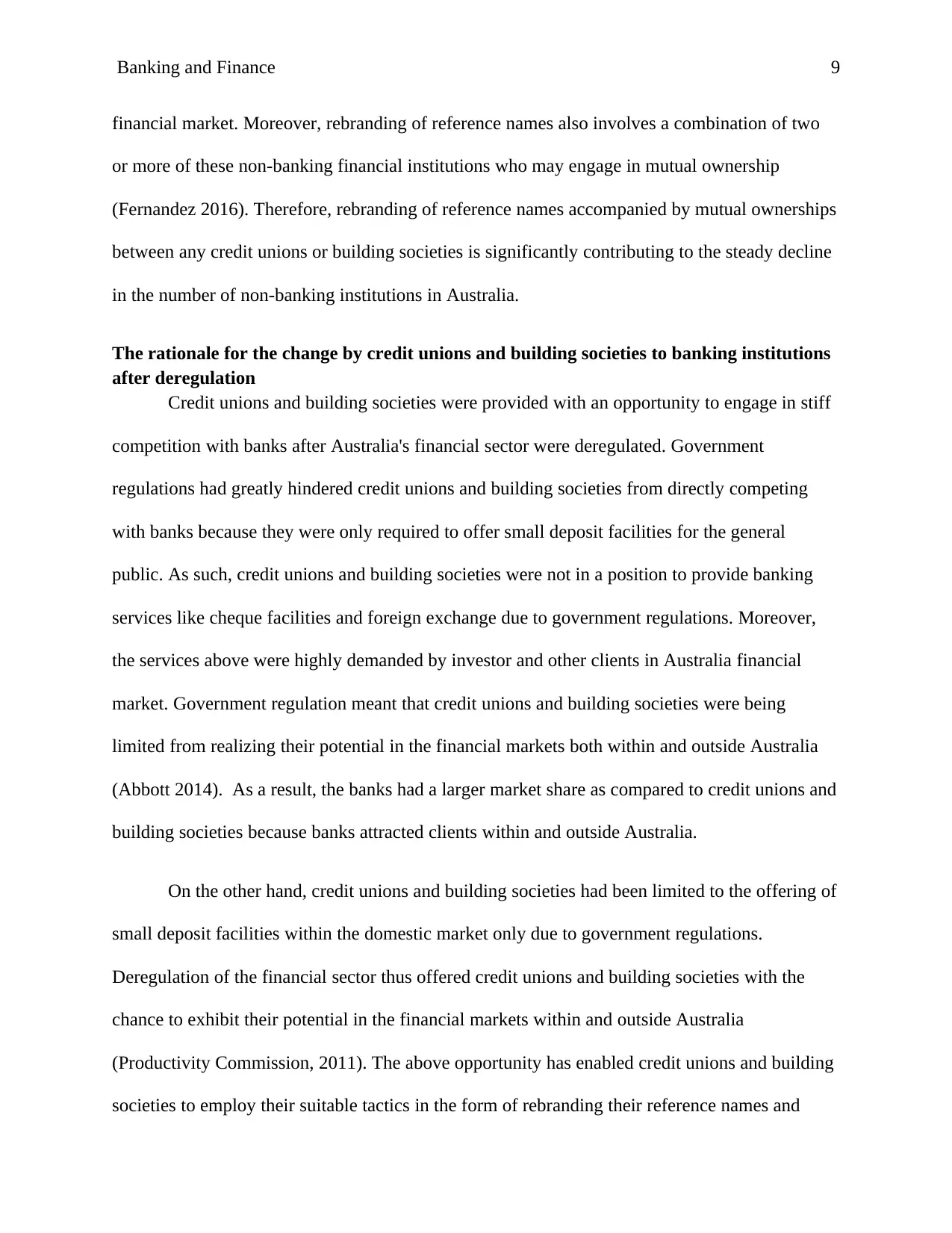
Banking and Finance 9
financial market. Moreover, rebranding of reference names also involves a combination of two
or more of these non-banking financial institutions who may engage in mutual ownership
(Fernandez 2016). Therefore, rebranding of reference names accompanied by mutual ownerships
between any credit unions or building societies is significantly contributing to the steady decline
in the number of non-banking institutions in Australia.
The rationale for the change by credit unions and building societies to banking institutions
after deregulation
Credit unions and building societies were provided with an opportunity to engage in stiff
competition with banks after Australia's financial sector were deregulated. Government
regulations had greatly hindered credit unions and building societies from directly competing
with banks because they were only required to offer small deposit facilities for the general
public. As such, credit unions and building societies were not in a position to provide banking
services like cheque facilities and foreign exchange due to government regulations. Moreover,
the services above were highly demanded by investor and other clients in Australia financial
market. Government regulation meant that credit unions and building societies were being
limited from realizing their potential in the financial markets both within and outside Australia
(Abbott 2014). As a result, the banks had a larger market share as compared to credit unions and
building societies because banks attracted clients within and outside Australia.
On the other hand, credit unions and building societies had been limited to the offering of
small deposit facilities within the domestic market only due to government regulations.
Deregulation of the financial sector thus offered credit unions and building societies with the
chance to exhibit their potential in the financial markets within and outside Australia
(Productivity Commission, 2011). The above opportunity has enabled credit unions and building
societies to employ their suitable tactics in the form of rebranding their reference names and
financial market. Moreover, rebranding of reference names also involves a combination of two
or more of these non-banking financial institutions who may engage in mutual ownership
(Fernandez 2016). Therefore, rebranding of reference names accompanied by mutual ownerships
between any credit unions or building societies is significantly contributing to the steady decline
in the number of non-banking institutions in Australia.
The rationale for the change by credit unions and building societies to banking institutions
after deregulation
Credit unions and building societies were provided with an opportunity to engage in stiff
competition with banks after Australia's financial sector were deregulated. Government
regulations had greatly hindered credit unions and building societies from directly competing
with banks because they were only required to offer small deposit facilities for the general
public. As such, credit unions and building societies were not in a position to provide banking
services like cheque facilities and foreign exchange due to government regulations. Moreover,
the services above were highly demanded by investor and other clients in Australia financial
market. Government regulation meant that credit unions and building societies were being
limited from realizing their potential in the financial markets both within and outside Australia
(Abbott 2014). As a result, the banks had a larger market share as compared to credit unions and
building societies because banks attracted clients within and outside Australia.
On the other hand, credit unions and building societies had been limited to the offering of
small deposit facilities within the domestic market only due to government regulations.
Deregulation of the financial sector thus offered credit unions and building societies with the
chance to exhibit their potential in the financial markets within and outside Australia
(Productivity Commission, 2011). The above opportunity has enabled credit unions and building
societies to employ their suitable tactics in the form of rebranding their reference names and
⊘ This is a preview!⊘
Do you want full access?
Subscribe today to unlock all pages.

Trusted by 1+ million students worldwide
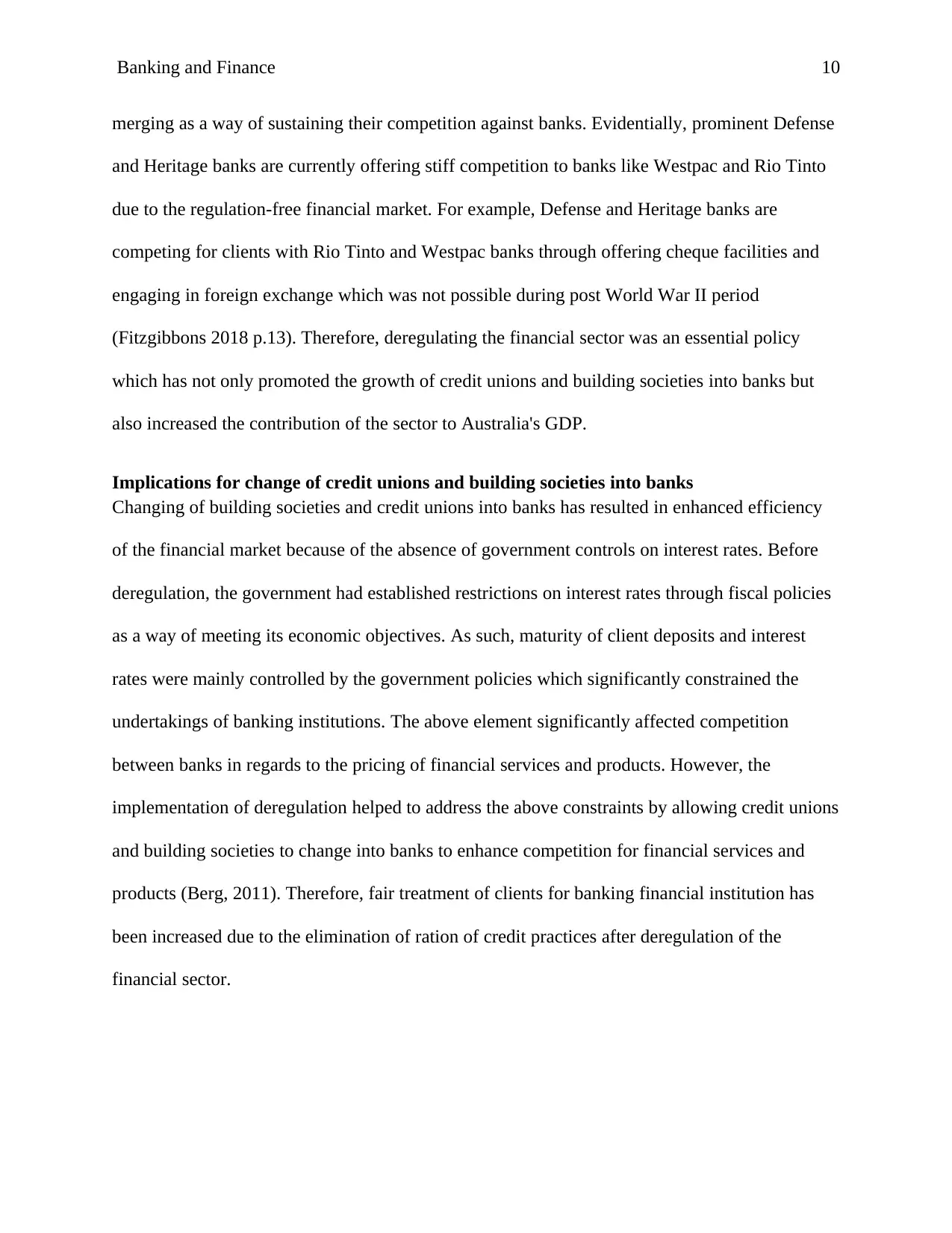
Banking and Finance 10
merging as a way of sustaining their competition against banks. Evidentially, prominent Defense
and Heritage banks are currently offering stiff competition to banks like Westpac and Rio Tinto
due to the regulation-free financial market. For example, Defense and Heritage banks are
competing for clients with Rio Tinto and Westpac banks through offering cheque facilities and
engaging in foreign exchange which was not possible during post World War II period
(Fitzgibbons 2018 p.13). Therefore, deregulating the financial sector was an essential policy
which has not only promoted the growth of credit unions and building societies into banks but
also increased the contribution of the sector to Australia's GDP.
Implications for change of credit unions and building societies into banks
Changing of building societies and credit unions into banks has resulted in enhanced efficiency
of the financial market because of the absence of government controls on interest rates. Before
deregulation, the government had established restrictions on interest rates through fiscal policies
as a way of meeting its economic objectives. As such, maturity of client deposits and interest
rates were mainly controlled by the government policies which significantly constrained the
undertakings of banking institutions. The above element significantly affected competition
between banks in regards to the pricing of financial services and products. However, the
implementation of deregulation helped to address the above constraints by allowing credit unions
and building societies to change into banks to enhance competition for financial services and
products (Berg, 2011). Therefore, fair treatment of clients for banking financial institution has
been increased due to the elimination of ration of credit practices after deregulation of the
financial sector.
merging as a way of sustaining their competition against banks. Evidentially, prominent Defense
and Heritage banks are currently offering stiff competition to banks like Westpac and Rio Tinto
due to the regulation-free financial market. For example, Defense and Heritage banks are
competing for clients with Rio Tinto and Westpac banks through offering cheque facilities and
engaging in foreign exchange which was not possible during post World War II period
(Fitzgibbons 2018 p.13). Therefore, deregulating the financial sector was an essential policy
which has not only promoted the growth of credit unions and building societies into banks but
also increased the contribution of the sector to Australia's GDP.
Implications for change of credit unions and building societies into banks
Changing of building societies and credit unions into banks has resulted in enhanced efficiency
of the financial market because of the absence of government controls on interest rates. Before
deregulation, the government had established restrictions on interest rates through fiscal policies
as a way of meeting its economic objectives. As such, maturity of client deposits and interest
rates were mainly controlled by the government policies which significantly constrained the
undertakings of banking institutions. The above element significantly affected competition
between banks in regards to the pricing of financial services and products. However, the
implementation of deregulation helped to address the above constraints by allowing credit unions
and building societies to change into banks to enhance competition for financial services and
products (Berg, 2011). Therefore, fair treatment of clients for banking financial institution has
been increased due to the elimination of ration of credit practices after deregulation of the
financial sector.
Paraphrase This Document
Need a fresh take? Get an instant paraphrase of this document with our AI Paraphraser
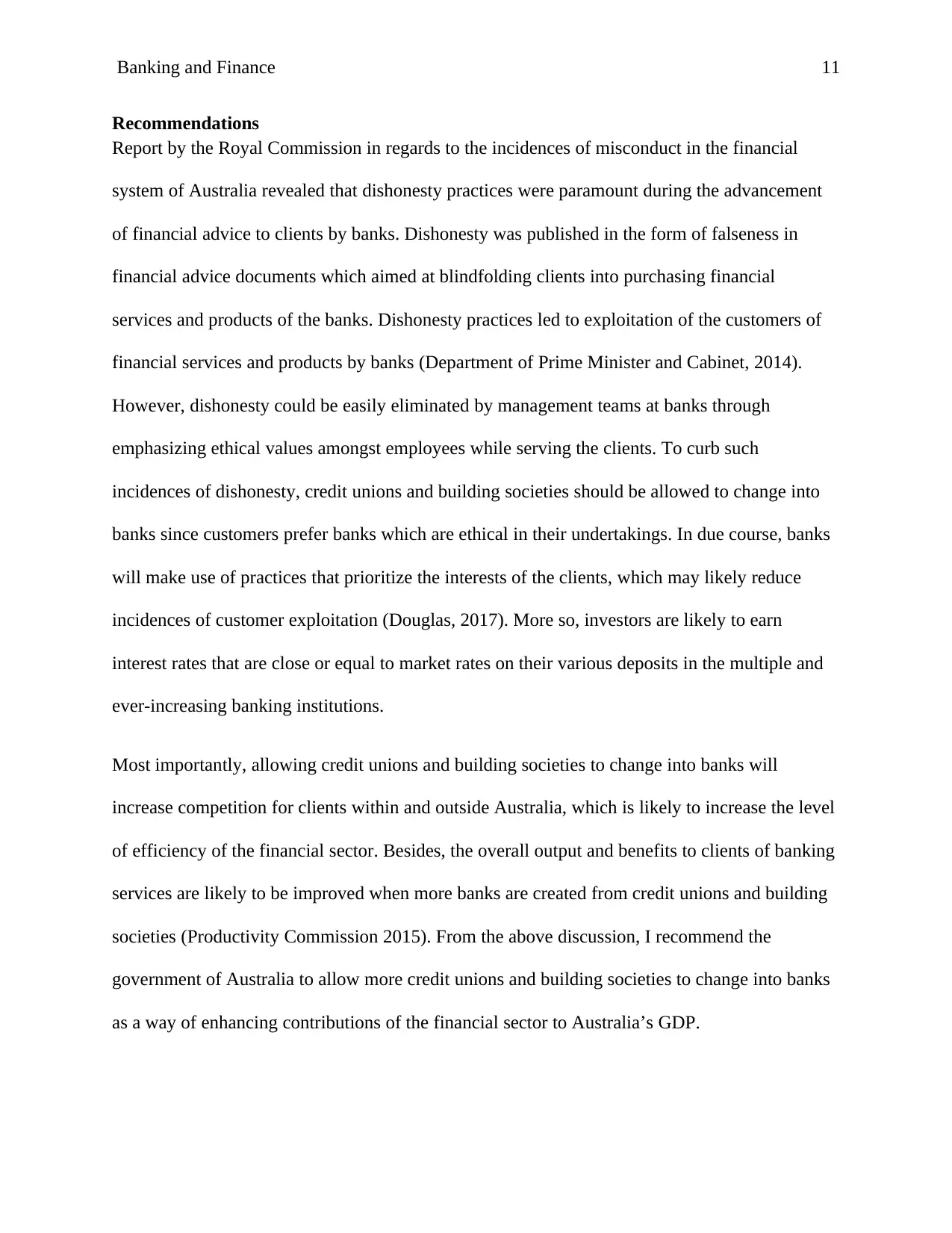
Banking and Finance 11
Recommendations
Report by the Royal Commission in regards to the incidences of misconduct in the financial
system of Australia revealed that dishonesty practices were paramount during the advancement
of financial advice to clients by banks. Dishonesty was published in the form of falseness in
financial advice documents which aimed at blindfolding clients into purchasing financial
services and products of the banks. Dishonesty practices led to exploitation of the customers of
financial services and products by banks (Department of Prime Minister and Cabinet, 2014).
However, dishonesty could be easily eliminated by management teams at banks through
emphasizing ethical values amongst employees while serving the clients. To curb such
incidences of dishonesty, credit unions and building societies should be allowed to change into
banks since customers prefer banks which are ethical in their undertakings. In due course, banks
will make use of practices that prioritize the interests of the clients, which may likely reduce
incidences of customer exploitation (Douglas, 2017). More so, investors are likely to earn
interest rates that are close or equal to market rates on their various deposits in the multiple and
ever-increasing banking institutions.
Most importantly, allowing credit unions and building societies to change into banks will
increase competition for clients within and outside Australia, which is likely to increase the level
of efficiency of the financial sector. Besides, the overall output and benefits to clients of banking
services are likely to be improved when more banks are created from credit unions and building
societies (Productivity Commission 2015). From the above discussion, I recommend the
government of Australia to allow more credit unions and building societies to change into banks
as a way of enhancing contributions of the financial sector to Australia’s GDP.
Recommendations
Report by the Royal Commission in regards to the incidences of misconduct in the financial
system of Australia revealed that dishonesty practices were paramount during the advancement
of financial advice to clients by banks. Dishonesty was published in the form of falseness in
financial advice documents which aimed at blindfolding clients into purchasing financial
services and products of the banks. Dishonesty practices led to exploitation of the customers of
financial services and products by banks (Department of Prime Minister and Cabinet, 2014).
However, dishonesty could be easily eliminated by management teams at banks through
emphasizing ethical values amongst employees while serving the clients. To curb such
incidences of dishonesty, credit unions and building societies should be allowed to change into
banks since customers prefer banks which are ethical in their undertakings. In due course, banks
will make use of practices that prioritize the interests of the clients, which may likely reduce
incidences of customer exploitation (Douglas, 2017). More so, investors are likely to earn
interest rates that are close or equal to market rates on their various deposits in the multiple and
ever-increasing banking institutions.
Most importantly, allowing credit unions and building societies to change into banks will
increase competition for clients within and outside Australia, which is likely to increase the level
of efficiency of the financial sector. Besides, the overall output and benefits to clients of banking
services are likely to be improved when more banks are created from credit unions and building
societies (Productivity Commission 2015). From the above discussion, I recommend the
government of Australia to allow more credit unions and building societies to change into banks
as a way of enhancing contributions of the financial sector to Australia’s GDP.
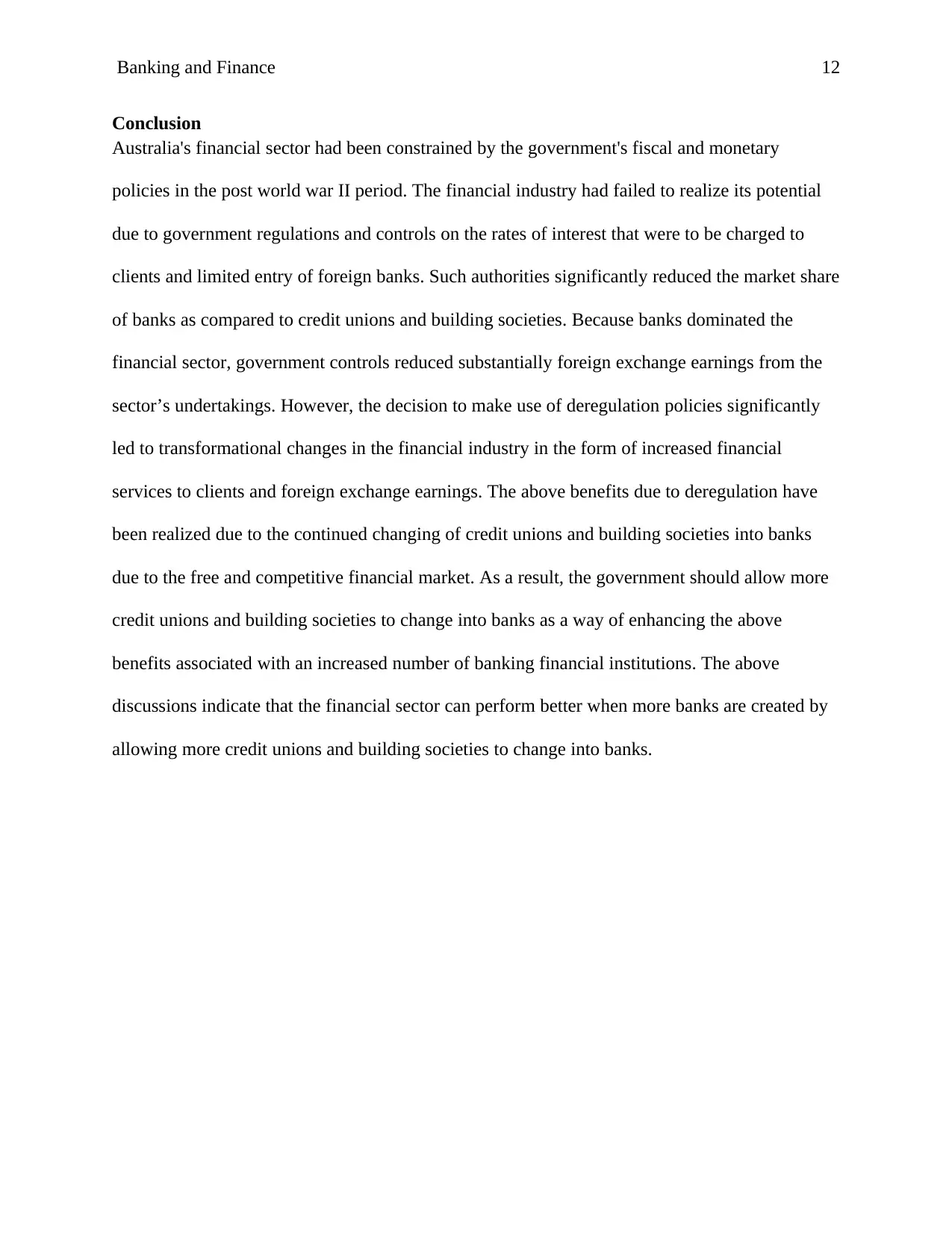
Banking and Finance 12
Conclusion
Australia's financial sector had been constrained by the government's fiscal and monetary
policies in the post world war II period. The financial industry had failed to realize its potential
due to government regulations and controls on the rates of interest that were to be charged to
clients and limited entry of foreign banks. Such authorities significantly reduced the market share
of banks as compared to credit unions and building societies. Because banks dominated the
financial sector, government controls reduced substantially foreign exchange earnings from the
sector’s undertakings. However, the decision to make use of deregulation policies significantly
led to transformational changes in the financial industry in the form of increased financial
services to clients and foreign exchange earnings. The above benefits due to deregulation have
been realized due to the continued changing of credit unions and building societies into banks
due to the free and competitive financial market. As a result, the government should allow more
credit unions and building societies to change into banks as a way of enhancing the above
benefits associated with an increased number of banking financial institutions. The above
discussions indicate that the financial sector can perform better when more banks are created by
allowing more credit unions and building societies to change into banks.
Conclusion
Australia's financial sector had been constrained by the government's fiscal and monetary
policies in the post world war II period. The financial industry had failed to realize its potential
due to government regulations and controls on the rates of interest that were to be charged to
clients and limited entry of foreign banks. Such authorities significantly reduced the market share
of banks as compared to credit unions and building societies. Because banks dominated the
financial sector, government controls reduced substantially foreign exchange earnings from the
sector’s undertakings. However, the decision to make use of deregulation policies significantly
led to transformational changes in the financial industry in the form of increased financial
services to clients and foreign exchange earnings. The above benefits due to deregulation have
been realized due to the continued changing of credit unions and building societies into banks
due to the free and competitive financial market. As a result, the government should allow more
credit unions and building societies to change into banks as a way of enhancing the above
benefits associated with an increased number of banking financial institutions. The above
discussions indicate that the financial sector can perform better when more banks are created by
allowing more credit unions and building societies to change into banks.
⊘ This is a preview!⊘
Do you want full access?
Subscribe today to unlock all pages.

Trusted by 1+ million students worldwide
1 out of 15
Related Documents
Your All-in-One AI-Powered Toolkit for Academic Success.
+13062052269
info@desklib.com
Available 24*7 on WhatsApp / Email
![[object Object]](/_next/static/media/star-bottom.7253800d.svg)
Unlock your academic potential
Copyright © 2020–2025 A2Z Services. All Rights Reserved. Developed and managed by ZUCOL.





